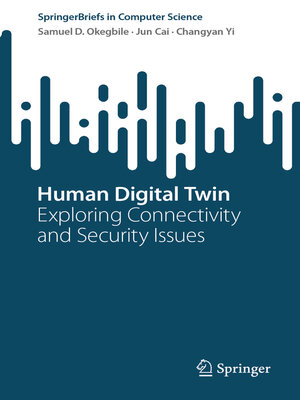Human Digital Twin
ebook ∣ Exploring Connectivity and Security Issues · SpringerBriefs in Computer Science
By Samuel D. Okegbile

Sign up to save your library
With an OverDrive account, you can save your favorite libraries for at-a-glance information about availability. Find out more about OverDrive accounts.
Find this title in Libby, the library reading app by OverDrive.



Search for a digital library with this title
Title found at these libraries:
| Library Name | Distance |
|---|---|
| Loading... |
Human digital twin (HDT) is a transformative technology poised to transform various human-centric systems. With its potential applications in personalized healthcare, HDT promises swift, precise, and efficient healthcare services through the integration of cutting-edge technologies such as artificial intelligence, data analytics, internet of things, cybersecurity as well as virtual and augmented reality. This book addresses the critical gap in the existing literature by offering a comprehensive exploration of connectivity solutions for HDT while prioritizing reliability, security, and privacy. Key topics covered include the foundational concept of HDT, its design requirements and associated challenges, edge-assisted human-to-virtual solutions, blockchain-enabled data-sharing mechanisms, and differentially private federated multi-task learning (DPFML) methodologies tailored for HDT.
The discussion on the concept of HDT encompasses an overview of its applications and its specific characteristics when compared to the conventional digital twin models. In addressing the design requirements and challenges of HDT, the text delves into the complexities of securing high-quality data, ensuring ultra-reliable and low-latency communication, data privacy and integrity, while managing storage, computation and analytics. Exploring edge-assisted human-to-virtual solutions, the book also introduces a connectivity framework and details the modeling process for human-to-virtual twin connectivity. The book later presents an in-depth examination of the practical Byzantine fault tolerance framework, followed by a discussion on shard-based Byzantine fault-tolerant schemes tailored for HDT, along with analyses of latency and throughput.
Furthermore, the book outlines the framework for DPFML-assisted human-to-virtual twin connectivity, accompanied by a novel consensus algorithm known as the proof of model quality. Finally, it presents future research directions aimed at addressing communication challenges hindering the seamless design and development of HDT. By offering this comprehensive exploration, the book serves as a valuable resource for researchers, practitioners, and policymakers seeking to navigate the evolving landscape of HDT and its transformative potential in various domains.
The discussion on the concept of HDT encompasses an overview of its applications and its specific characteristics when compared to the conventional digital twin models. In addressing the design requirements and challenges of HDT, the text delves into the complexities of securing high-quality data, ensuring ultra-reliable and low-latency communication, data privacy and integrity, while managing storage, computation and analytics. Exploring edge-assisted human-to-virtual solutions, the book also introduces a connectivity framework and details the modeling process for human-to-virtual twin connectivity. The book later presents an in-depth examination of the practical Byzantine fault tolerance framework, followed by a discussion on shard-based Byzantine fault-tolerant schemes tailored for HDT, along with analyses of latency and throughput.
Furthermore, the book outlines the framework for DPFML-assisted human-to-virtual twin connectivity, accompanied by a novel consensus algorithm known as the proof of model quality. Finally, it presents future research directions aimed at addressing communication challenges hindering the seamless design and development of HDT. By offering this comprehensive exploration, the book serves as a valuable resource for researchers, practitioners, and policymakers seeking to navigate the evolving landscape of HDT and its transformative potential in various domains.







